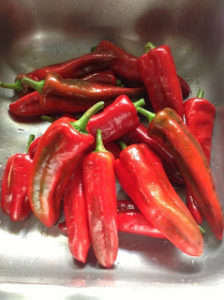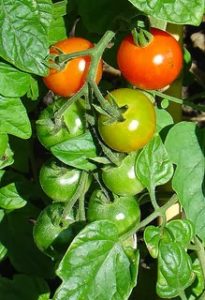
Welcome to part 2 in a series of posts about the late summer garden harvest. (Part 1, on the cucurbits, is here; part 3, on the drupes, is here.) Today we’re going to look at the Solanaceae, or nightshades.
Solanaceae is a large family that includes edible species such as tomatoes, peppers, eggplant, and potatoes, along with a great many other things (petunias, the hallucinogenic datura, and the poisonous deadly nightshade, for example). The origin of the name Solanaceae is unclear, but it may rest on an association of certain plants in the family with either the sun or with a soothing effect produced by ingesting them.
Sweet peppers, chili peppers, and tomatoes are New World plants. Those lovely things on the left are red peppers, fine specimens of the species Capsicum annuum, which is the most common of the cultivated Capsicum species.
Columbus brought back some variety of Capsicum annuum to Europe, and it was given the common name pepper because it was spicy, like the unrelated black pepper that Europeans were already familiar with, although it packed more of a punch. It’s not clear where the genus name Capsicum came from, although it may be derived from the Latin capsa, or box, presumably for the blocky hollow shape of many varieties. Capsaicin, the name of the compound that gives chili peppers their heat, is derived from capsicum.

The tomato, quintessential summer harvest and beloved of gardeners today, was once considered poisonous in Europe and North America. Columbus introduced it to Europe after his first voyage to the New World (it probably first appeared in Peru or Mexico). The plant’s resemblance to deadly nightshade made it an object of suspicion, although it also made it possible for Linnaeus to correctly classify it as belonging to the same family, the Solanaceae.
An early common name in Europe was the German wolfpirisch, or wolf peach. The peach part was for its physical appearance, and the wolf part comes from a belief that the tomato, like nightshade, could be used to conjure werewolves. (Definitely an unsavory plant, then, in this early view.)
The scientific name is Solanum lycopersicum, and the species name lycopersicum is essentially the Latin version of wolf peach. As we saw in an earlier post, lyco comes from the Greek word for wolf; malum persicum, or Persian apple, is what the Romans called peaches. (We’ll learn more about peaches later in the week when we talk about the drupes in the genus Prunus.) The wolfish connection lingers, linguistically anyway, in the name lycopene, which refers to an antioxidant compound found in tomatoes (and also red peppers, incidentally). The English common name, tomato, comes from the Nahuatl word tomatl.
Other early common names indicate more favorable views of the tomato. The Italian pomodoro, or golden apple, suggests the relative speed with which Italian cooks (and eaters) adopted the tomato, first as decoration for the table and then as edible and even tasty. The French pomme d’amour or love-apple reflects the belief that it was an aphrodisiac.
In England and North America, it took longer to persuade people that tomatoes were harmless. I’ve read of people growing what they called love-apples as ornamental potted plants in 1850s America, believing they were poisonous to eat but appealing to the eye. There are competing stories for what finally moved tomatoes from poisonous to palatable in the public mind in the US, and the truth is shrouded in mystery. Suffice it to say that when Campbell’s condensed tomato soup was introduced in 1897, the tomato was in the kitchen, and the garden, to stay.
We’ll look at one more nightshade, this one from India rather than the Americas. The eggplant probably reached Europe some time in the early Middle Ages. The English common name is traced back to yellow or white varieties grown in the 17th century that looked something like goose eggs or hen’s eggs. The scientific name, Solanum melongena, has a more complicated history. Byzantine Greek borrowed and adapted the Arabic name, which in turn came from a Dravidian word. The Greek version, melitzána, then made it into medieval Latin, there to be picked up by botanists when it came time to assign an official name. Another Arabic word eventually morphed into the French aubergine and similar words in other languages.
Later in the week, we’ll close this series with part 3, which will look at the drupes of the genus Prunus.
Learn more:
- This Smithsonian.com blog post explains why tomatoes were once fearful objects.
- The Nibble has a chili glossary.
- Vegetarians in Paradise has a history of the eggplant.